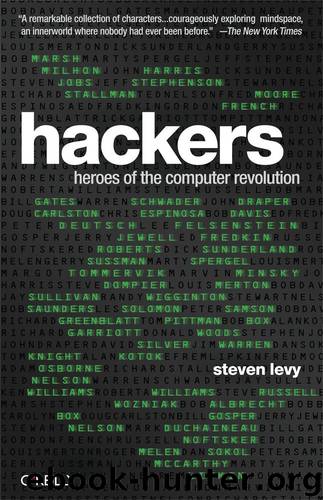Hackers : Heroes of the Computer Revolution by Steven Levy

Author:Steven Levy [Levy, Steven]
Language: eng
Format: epub
Tags: Nonfiction
Publisher: http://c3jemx2ube5v5zpg.onion
Published: 1984-11-29T16:00:00+00:00
Chapter 12. Woz
Steve Wozniak did not sit near the front of the SLAC auditorium along with Lee Felsenstein during Homebrew meetings. His participation in the mapping sessions were infrequent. He had no great social scheme, did not incubate plans for a Community Memory-style assault on the foundations of the batch-processed society. Meeting after meeting, Steve Wozniak would be at the back of the room, along with a loose contingent of followers of his digital exploits—mostly high school-age computer nuts drawn by the sheer charisma of his hacking. He looked like a bum. His hair fell haphazardly on his shoulders, he had the kind of beard grown more to obviate the time-consuming act of shaving than to enhance appearance, and his clothes—jeans and sports shirts, with little variation—never seemed to fit quite right.
Still, it was Steve Wozniak, known to his friends as “Woz,” who would best exemplify the spirit and the synergy of the Homebrew Computer Club. It was Wozniak and the computer he’d design that would take the Hacker Ethic, at least in terms of hardware hacking, to its apogee. It would be the legacy of the Homebrew.
Stephen Wozniak did not reach his views of hackerism through personal struggle and political rumination as Lee Felsenstein did. He was more like Richard Greenblatt and Stew Nelson: a born hacker. He grew up in Cupertino, California, amidst the curving streets lined with small single-family homes and the one-story, sparsely windowed buildings that sowed the crop of silicon which would be so central to his existence. Even in grammar school, Wozniak could get so engrossed in mathematical ponderings that his mother had to rap on his head to bring him back to the real world. He won a science contest at thirteen for building a computer-like machine which could add and subtract. His friend Alan Baum later remembered him at Homestead High School: “I saw a guy scribbling these neat diagrams on a piece of paper. I said, ‘What’s that?’ He said, ‘I’m designing a computer.’ He had taught himself how to do it.”
Baum was impressed enough to join this unusual classmate in a quest for computer access, and through contacts in the engineering-rich Silicon Valley they managed to get on various time-sharing computers. Every Wednesday they would leave school and have a friend sneak them into a computer room at the Sylvania company. They’d program the machine to do things like printing out all the powers of two and finding the primes. The two followed the computer industry with the serious passion with which fanatic sports fans might follow favorite teams. Every time they heard of a new minicomputer being released, they would write to the manufacturer, be it Digital or Control Data or whoever, and request the manual, a request often routinely fulfilled. When the manual came, they would devour it. They would instantly turn to the part which described the computer’s instruction set. They would note how many registers the machine had, how it added, how it did multiplication, division.
Download
This site does not store any files on its server. We only index and link to content provided by other sites. Please contact the content providers to delete copyright contents if any and email us, we'll remove relevant links or contents immediately.
Mastering Bitcoin: Programming the Open Blockchain by Andreas M. Antonopoulos(3011)
Dawn of the New Everything by Jaron Lanier(2751)
Blockchain: Ultimate Step By Step Guide To Understanding Blockchain Technology, Bitcoin Creation, and the future of Money (Novice to Expert) by Keizer Söze(2467)
Alibaba by Duncan Clark(2057)
Foundations of Blockchain by Koshik Raj(1969)
Owning Bitcoin: The Illustrated Guide to Security, Privacy, and Potential by Apodaca Richard(1952)
Significant Zero by Walt Williams(1948)
The Mastermind by Evan Ratliff(1918)
Mastering Blockchain by Imran Bashir(1851)
Bitcoin: The Basics of Blockchain and Investing in Cryptocurrency by K. Connors(1796)
Bitcoin: The Ultimate Guide to the World of Bitcoin, Bitcoin Mining, Bitcoin Investing, Blockchain Technology, Cryptocurrency (2nd Edition) by Ikuya Takashima(1675)
Attack of the 50 Foot Blockchain by David Gerard(1667)
Turing's Cathedral by George Dyson(1650)
The Bitcoin Standard: The Decentralized Alternative to Central Banking by Saifedean Ammous(1644)
Cryptocurrency by Neil Hoffman(1624)
Shaping the Fourth Industrial Revolution by Klaus Schwab & Nicholas Davis & Satya Nadella(1608)
Dawn of the New Everything: Encounters with Reality and Virtual Reality by Jaron Lanier(1598)
The Bitcoin Guidebook by Ian DeMartino(1594)
Bill Gates by Michael Becraft(1552)
